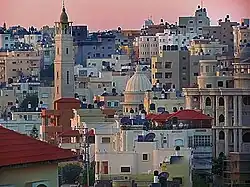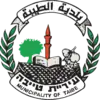Tayibe
Tayibe, also spelled Taibeh or Tayiba, (Arabic: الطَّيِّبَة, romanized: et-Tayyibe, lit. 'the kind/benevolent', South Levantine pronunciation: [etˈtˤɑjbe]; Hebrew: טַיִּבָּה) is an Arab city in central Israel, 12 km (7 mi) north east of Kfar Saba.[3] Part of the Triangle region, in 2021 it had a population of 45,388.[1] Its citizens are Arab-Muslims.
Tayibe
| |
|---|---|
City (from 1990) | |
| Hebrew transcription(s) | |
| • Also spelled | Tayiba (unofficial) |
 | |
 | |
 Tayibe  Tayibe | |
| Coordinates: 32°16′0″N 35°00′37″E | |
| Grid position | 151/185 PAL |
| Country | |
| District | Central |
| Area | |
| • Total | 18,662 dunams (18.662 km2 or 7.205 sq mi) |
| Population (2021)[1] | |
| • Total | 45,388 |
| • Density | 2,400/km2 (6,300/sq mi) |
| Name meaning | The Goodly[2] |
History
A village called Tayyibat al-Ism was on the list of lands allocated by sultan Baibars to his amirs in 663 AH (1265–1266 CE), about five centuries after the Arab conquest of Palestine. In Mamluk times, the village name appeared on documents referring to the waqf of the mosque in Hebron.[4] It has been suggested that the village is identical with Tivata (טיבתה), a settlement mentioned in the Talmud.[5]
Ottoman Empire
Under Ottoman rule after 1517, a sijill (royal order) from 941/1535 gave 1/3 of the revenue from Tayyibat al-Ism to Ribat al-Mansuri (Com.); a hospital in Jerusalem started by Al-Mansur Qalawun in 1282.[6] The tax register of 1596 shows the village was under the administration of the nahiya of Bani Sab. With a population of 50 households ("khana") and 5 bachelors, all Muslim, who paid a fixed tax rate of 33,3% on various agricultural products, including wheat, barley, summer crops (including gura, melons, beans, vegetables etc.), olive trees, beehives and goats; a total of 19,800 akçe. All of the revenue went to a waqf.[7] Pierre Jacotin called the village Taibeh on his map in 1799.[8]
In the 1860s, the Ottoman authorities granted the village agricultural plots of land called Ghabat al-Taiyiba al-Shamaliyya and Ghabat al-Taiyiba al-Qibliyya in the former confines of the Forest of Arsur (Ar. Al-Ghaba) in the coastal plain, west of the village.[9][10]
In 1870/1871 (1288 AH), an Ottoman census listed the village in the nahiya (sub-district) of Bani Sa'b.[11]
The French explorer Victor Guérin described it as a village south of Fardisya,[12] while in the 1882 "Survey of Western Palestine", Tayibe was described as: "a large straggling village on the end of a slope, principally built of stone. It is supplied by cisterns and surrounded with olives."[13]
British Mandate
In the 1922 census of Palestine, ‘’Taibeh’’ had a population of 2,350, all Muslims,[14] increasing in the 1931 census, to 2,944, all Muslim, living in 658 houses. The count may have included two nearby Bedouin tribes.[15]
In the 1945 statistics the population was 4,290 Muslims,[16] while the land area was 32,750 dunams, according to an official land and population survey. This included some nearby Arab communities.[17] Of this, 559 were allocated for citrus and bananas, 3,180 plantations and irrigable land, 23,460 for cereals,[18] while 281 dunams were classified as built-up areas.[19]
 Tayibe 1942 1:20,000
Tayibe 1942 1:20,000 Tayibe 1945 1:250,000
Tayibe 1945 1:250,000
Israel
During the 1948 Arab–Israeli War, Israeli forces captured the town lands, but not the town itself. Tayibe was transferred to Israel as part of the 1949 cease-fire agreement with Jordan.[3] According to David Gilmour, "the inhabitants were furious that Abdullah I of Jordan had simply handed them over to Israel but were relieved that they were to be reunited with their land. However, the Law of Acquisition of Absentee Property, which was passed in 1950 but made retroactive, was specially devised to take care of cases like this. Although they had not moved from their village, the inhabitants were declared 'absentees' and their land 'abandoned property'. According to the villagers, they lost 8,000 acres (3,237.49 ha) of their 11,000 acres (4,451.54 ha)."[20]
Tayibe achieved local council status in 1952. In 1990, it was declared a city.[3]
In 2022, the Supreme Court ruled that the 2017 seizure of 7.5 acres (3.04 ha) by the same legal device was permitted and charged costs to the petitioners.[21] The families involved were refused access to the maps on which the ruling was based on "national security" grounds.[21] Haaretz described the move as "legalized theft", "in defiance of both the spirit of the law and its rationale".[22]
Demographics

According to CBS, in 2001 the ethnic makeup of the city was 100.0% Arab (99.7% Muslim), with no significant Jewish population. In 2001 there were 15,100 males and 14,500 females. 47.5% of the population was 19 years of age or younger, 17.4% between 20 and 29, 20.3% between 30 and 44, 9.6% from 45 to 59, 2.0% from 60 to 64, and 3.3% 65 years of age or older. The population growth rate in 2001 was 3.2%. In 2011, it had a population of 38,575.[23]
Tayibe had an estimated population of 40,200 in 2014, up from 35,700 in the 2008 census.[24]
The population of Tayibe, one of the largest and most developed Arab localities in Israel, is made up of 20 extended families, all Muslim.[25]
Landmarks


An ancient oak tree in Tayibe was declared the largest in Israel. The oak has a trunk circumference of 690 centimeters. According to local legend, there is an angel that watches over the tree and avenges any damage to it. It is said to be 1,400 years old, although this has not been scientifically proven.[26]
Education and culture
In 2001, there were 13 schools with a total enrollment of 6,970 students: 9 elementary schools (3,984 students) and 4 high schools (2,986 students). Nearly half of all 12th graders completed their Bagrut matriculation exams.
An educational empowerment project has been operating in Tayibe since 2006 to reduce the dropout rate among Bedouin students. The students receive extra help in Arabic, Hebrew, English and math, and attend special enrichment workshops in inter-personal communication. Following the success of this project, the project has been expanded to nearby Qalansawe and other Arab villages in Israel.[27]
The Tayibe Women Against Violence organization was established to work against violence in the community. The organization offers seminars and workshops that increase women's awareness of their rights and helps them find jobs.[28]
Sports
The now-defunct Hapoel Tayibe F.C. were the first Israeli Arab club to play in the top division of Israeli football.[29]
Notable people
- Senan Abdelqader, architect and urban planner[30]
- Hussniya Jabara, member of the Knesset, Meretz
- Abdallah Jaber (born 1993), footballer for Israeli Premier League club Hapoel Hadera
- Kais Nashef, actor
- Mahmud A-Nashaf (1906–1979), member of the Knesset
- Ahmad Tibi, member of the Knesset, Ta'al
- Abdul Latif Tibawi (1910–1981), historian and educationalist
- Rafik Haj Yahia (1949–2000), member of the Knesset
- Walid Haj Yahia, member of the Knesset, Meretz
- Dr. Samer Haj Yahia, Chairman of Bank Leumi[31]
- Dr. Ghassan Yassin, Professor of Astrophysics, University of Oxford[32]
- Dr. Gehad Mazarweh, Psychological Psychotherapist in Freiburg/Germany[33]
- Dr. Saleem Haj-Yahia, Heart & Transplant Surgeon, Professor[34]
References
- "Regional Statistics". Israel Central Bureau of Statistics. Retrieved 22 February 2023.
- Palmer, 1881, p. 193
- About Tayibe Archived 6 July 2008 at the Wayback Machine
- Petersen, 2001, pp. 296–298
- Orni, Efraim (2007). "ṬAYYIBA, AL". In Skolnik, Fred; Berenbaum, Michael (eds.). Encyclopaedia Judaica. Vol. 19. Macmillan. p. 562. ISBN 9780028659367.
- Burgoyne, 1987, p. 131
- Hütteroth and Abdulfattah, 1977, p. 141
- Karmon, 1960, p. 170
- Marom, Roy, "The Contribution of Conder's Tent Work in Palestine for the Understanding of Shifting Geographical, Social and Legal Realities in the Sharon during the Late Ottoman Period", in Gurevich D. and Kidron, A. (eds.), Exploring the Holy Land: 150 Years of the Palestine Exploration Fund, Sheffield, UK, Equinox (2019), pp. 212-231
- Marom, Roy (2022). "The Oak Forest of the Sharon (al-Ghaba) in the Ottoman Period: New Insights from Historical- Geographical Studies, Muse 5,". escholarship.org. Retrieved 2023-10-06.
- Grossman, David (2004). Arab Demography and Early Jewish Settlement in Palestine. Jerusalem: Magnes Press. p. 255.
- Guérin, 1875, p. 352
- Conder and Kitchener, 1882, p. 166. Cited in Petersen, 2001, p. 296
- Barron, 1923, p. 27.
- Mills, 1932, p. 58
- Department of Statistics, 1945, p. 22
- Government of Palestine, Department of Statistics. Village Statistics, April, 1945. Quoted in Hadawi, 1970, p. 76
- Government of Palestine, Department of Statistics. Village Statistics, April, 1945. Quoted in Hadawi, p. 128
- Government of Palestine, Department of Statistics. Village Statistics, April, 1945. Quoted in Hadawi, 1970, p. 178
- Walter Schwarz: The Arabs in Israel, Faber & Faber, London 1959, p. 40, and Israel and Palestine, No. 51 (August 1976), p. 1. Quoted in Gilmour, 1983, p. 106
- Nir Hasson (15 March 2022). "Israel Seized Land From Arab Citizens Based on Temporary 1948 Cease-fire Line". Haaretz.
- "Lead editorial". Haaretz. 15 March 2022.
- "Table 3 – Population of Localities Numbering Above 1,000 Residents and Other Rural Population" (PDF). Israel Central Bureau of Statistics. 30 June 2008. Retrieved 18 October 2008.
- "Statistical Abstract of Israel 2015 - Population and Density per Sq. Km. in Localities Numbering 5,000 Residents and More on 31 XII 2014". Israel Central Bureau of Statistics. 10 September 2015.
- Jaber, L.; Merlob, P.; Gabriel, R.; Shohat, M. (1997). "Effects of consanguineous marriage on reproductive outcome in an Arab community in Israel". Journal of Medical Genetics. 34 (12): 1000–1002. doi:10.1136/jmg.34.12.1000. PMC 1051151. PMID 9429142.
- Lightning strike brings new fame to giant old oak tree, Haaretz. Accessed 1 November 2022.
- Association for Education & Development, Alkhaimah.org. Accessed 1 November 2022.
- "Tayibe: A dream came true", wavo.org. Accessed 1 November 2022.
- It's a level playing field, Haaretz
- A jump start for Palestinian architecture – Haaretz – Israel News
- "Dr. Samer Haj Yehia Appointed Chairman of Bank Leumi - Bank Leumi".
- "Ghassan Yassin | University of Oxford Department of Physics".
- "Gehad Mazarweh: "Psychoanalyse ist ein Stück Revolution"".
- "Saleem Haj-Yahia".
Bibliography
- Barron, J.B., ed. (1923). Palestine: Report and General Abstracts of the Census of 1922. Government of Palestine.
- Burgoyne, Michael Hamilton (1987). Mamluk Jerusalem. ISBN 090503533X.
- Conder, C.R.; Kitchener, H.H. (1882). The Survey of Western Palestine: Memoirs of the Topography, Orography, Hydrography, and Archaeology. Vol. 2. London: Committee of the Palestine Exploration Fund.
- Department of Statistics (1945). Village Statistics, April, 1945. Government of Palestine.
- Gilmour, David (1983): Dispossessed. The Ordeal of the Palestinians. Sphere books, Great Britain, ISBN 0-7221-3842-3
- Guérin, V. (1875). Description Géographique Historique et Archéologique de la Palestine (in French). Vol. 2: Samarie, pt. 2. Paris: L'Imprimerie Nationale.
- Hadawi, S. (1970). Village Statistics of 1945: A Classification of Land and Area ownership in Palestine. Palestine Liberation Organization Research Center.
- Hütteroth, Wolf-Dieter; Abdulfattah, Kamal (1977). Historical Geography of Palestine, Transjordan and Southern Syria in the Late 16th Century. Erlanger Geographische Arbeiten, Sonderband 5. Erlangen, Germany: Vorstand der Fränkischen Geographischen Gesellschaft. ISBN 3-920405-41-2.
- Karmon, Y. (1960). "An Analysis of Jacotin's Map of Palestine" (PDF). Israel Exploration Journal. 10 (3, 4): 155–173, 244–253.
- Mills, E., ed. (1932). Census of Palestine 1931. Population of Villages, Towns and Administrative Areas. Jerusalem: Government of Palestine.
- Palmer, E.H. (1881). The Survey of Western Palestine: Arabic and English Name Lists Collected During the Survey by Lieutenants Conder and Kitchener, R. E. Transliterated and Explained by E.H. Palmer. Committee of the Palestine Exploration Fund.
- Petersen, Andrew (2001). A Gazetteer of Buildings in Muslim Palestine (British Academy Monographs in Archaeology). Vol. I. Oxford University Press. ISBN 978-0-19-727011-0.
External links
- Official website (in Arabic)
- Welcome To Tayyiba
- Survey of Western Palestine, Map 11: IAA, Wikimedia commons
